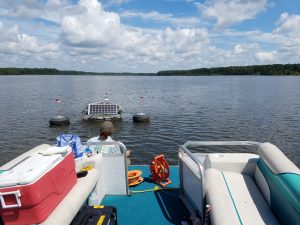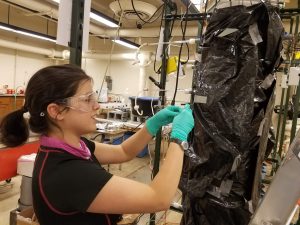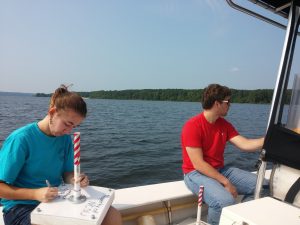Welcome to the home page of our research efforts related to lake mixing and harmful algal blooms. Below are a series of links/information about our ongoing and completed research projects.
Predicting the Effectiveness of Artificial Mixing for Controlling Algal Blooms in Piedmont Reservoirs
North Carolina Water Resources Research Institute (WRRI)
Tarek N. Aziz (PI), Daniel Obenour (Co-PI)
 This project was a two-year study of multiple reservoirs in the Piedmont of North Carolina. Our objectives were to one: (1) Execute field campaigns to characterize vertical diffusivity and water quality in Jordan Lake (Apex, NC), City Lake (Chapel Hill, NC), and University Lake (High Point, NC)., (2) Perform statistical (hierarchical) modeling of vertical diffusivity and phytoplankton concentrations to identify and quantify key biophysical relationships and test whether artificial mixing significantly alters vertical diffusivity and phyotoplankton concentration, (3) Perform mechanistic water column modeling to generalize the results obtained in Objective (2), and (4) Develop a decision support tool to predict vertical diffusivities under various lake and artificial mixing conditions. The three reservoirs considered in this study provided an opportunity to study biophysical lake characteristics under different mixing conditions. Jordan Lake included a deployment of solar-powered circulators, City Lake included compressed air mixing, and University Lake had no artificial mixing.
This project was a two-year study of multiple reservoirs in the Piedmont of North Carolina. Our objectives were to one: (1) Execute field campaigns to characterize vertical diffusivity and water quality in Jordan Lake (Apex, NC), City Lake (Chapel Hill, NC), and University Lake (High Point, NC)., (2) Perform statistical (hierarchical) modeling of vertical diffusivity and phytoplankton concentrations to identify and quantify key biophysical relationships and test whether artificial mixing significantly alters vertical diffusivity and phyotoplankton concentration, (3) Perform mechanistic water column modeling to generalize the results obtained in Objective (2), and (4) Develop a decision support tool to predict vertical diffusivities under various lake and artificial mixing conditions. The three reservoirs considered in this study provided an opportunity to study biophysical lake characteristics under different mixing conditions. Jordan Lake included a deployment of solar-powered circulators, City Lake included compressed air mixing, and University Lake had no artificial mixing.
Piedmont Reservoir Mixing Decision Support Tool
One of the objectives of the aforementioned study was to develop a decision support tool to explore the feasibility of artificial mixing in Piedmont reservoirs. To accomplish this, we ran a mechanistic heat budget model mentioned above with regionally relevant meteorological challenge conditions for a range of relevant lake parameters. Using this challenge condition, we ran the mechanistic heat budget model with artificial circulation across 256 conditions where we varied lake depths, wind sheltering conditions, Secchi depths, and artificial circulation rates. Mean daytime diffusion from each output was then exported for use with the decision support tool. To download the decision support tool please use the link below:
Piedmont Reservoir Mixing Decision Support Tool
Assessing physical controls on phytoplankton growth through mesocosms and modeling
North Carolina Policy Collaboratory (NCPC)
Tarek N. Aziz (PI), Daniel Obenour (Co-PI)
 The overall goal of this study is to explore the impacts of artificial mixing and turbidity on algal bloom dynamics. This project specifically aimed to leverage our past experimental work with water column reactors designed to study algal blooms in shallow waters as well as our modeling efforts to mechanistically predict vertical mixing within shallow system such as Jordan Lake (Apex, NC). Specifically, the objectives of this project are to:
The overall goal of this study is to explore the impacts of artificial mixing and turbidity on algal bloom dynamics. This project specifically aimed to leverage our past experimental work with water column reactors designed to study algal blooms in shallow waters as well as our modeling efforts to mechanistically predict vertical mixing within shallow system such as Jordan Lake (Apex, NC). Specifically, the objectives of this project are to:
- Explore the modeling of mechanistic phytoplankton growth/competition
- Experimentally explore the impacts of mixing and turbidity using water column reactors
Development of a Reservoir Column Reactor to Experimentally Evaluate the Effect of Mixing on Harmful Algal Communities
NC State Research Initial Seed Funding (RISF)
Tarek N. Aziz (PI), Astrid Schnetzer (Co-PI), Daniel Obenour (Co-PI)
 In this project we developed novel water column reactors (WCRs) to explore the role of various environmental factors on algal bloom dynamics. The WCRs are 2 m tall cylindrical acrylic mesocosm reactors designed with control of mixing and light and multiple to enable experimental control while also enabling the important spatial and temporal movement of phytoplankton in the water column.
In this project we developed novel water column reactors (WCRs) to explore the role of various environmental factors on algal bloom dynamics. The WCRs are 2 m tall cylindrical acrylic mesocosm reactors designed with control of mixing and light and multiple to enable experimental control while also enabling the important spatial and temporal movement of phytoplankton in the water column.
Effects of Enhanced Circulation on Vertical Mixing and Algal Blooms in Freshwater Reservoirs
National Science Foundation (RAPID)
Daniel Obenour (PI), Tarek N. Aziz (Co-PI)
 This work represented the first physical measurement of vertical turbulent diffusion on Jordan Lake and coincided with the deployment of solar powered ciruclators installed to mitigate algal bloom formation. In this study we performed a suite of water quality field measurements, deployed thermistor chains in the Jordan Lake study area and collaborated with Dr. Robyn Smyth of Bard College to perform a detailed characterization of mixing in and around the solar circulators.
This work represented the first physical measurement of vertical turbulent diffusion on Jordan Lake and coincided with the deployment of solar powered ciruclators installed to mitigate algal bloom formation. In this study we performed a suite of water quality field measurements, deployed thermistor chains in the Jordan Lake study area and collaborated with Dr. Robyn Smyth of Bard College to perform a detailed characterization of mixing in and around the solar circulators.